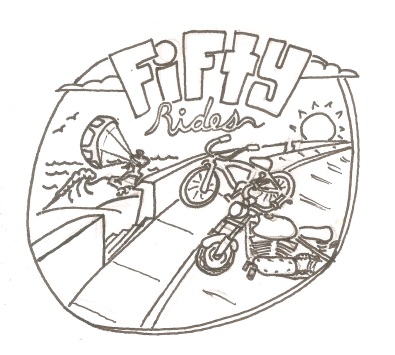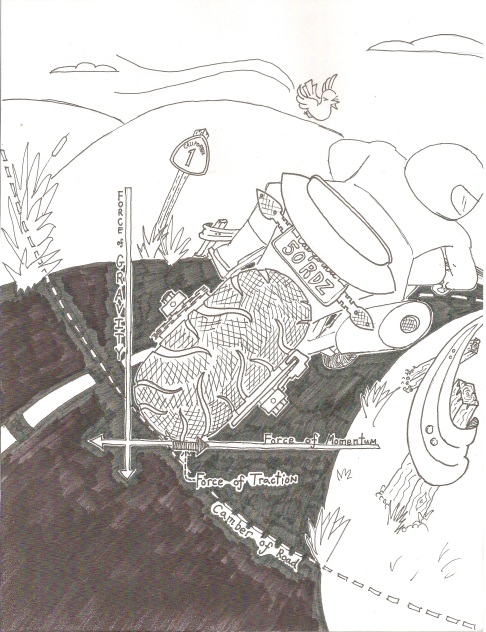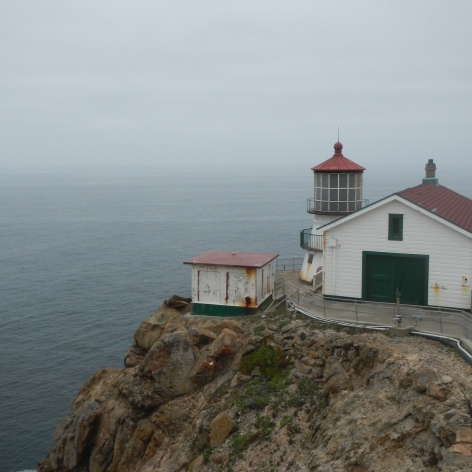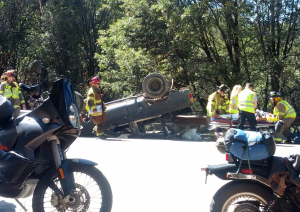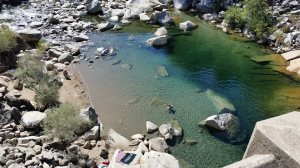
There’s a guy in a red polo shirt and radio headphones standing in front of a line of bikes. The jitters are creeping up. “Stay calm, stay calm,” I think, but I’m definitely not calm. People are watching, engines are roaring and I’m about to try going as fast as I can — at least it’s just in a straight line.
“The gas is on. The gas is on,” I tell myself as the mind runs over every checklist point again and again.
Three of us had ridden up earlier that day. Confused by the racing requirements, I’d worn a full leather suit and looked a little over dressed on my small cruiser. To get the best performance out of my little bike, I’d tightened and greased my chain, topped off the oil and checked my tire pressure. I’d removed the ammo-box-saddlebag from the side and purposefully ran low on gas during the ride up. After fueling up at the racetrack with about half a gallon of 100-octane racing fuel, I was ready to go. I just needed to know how to get in line. “Can you just lanesplit to the front?” Asks one of our group.
Looking at a line of cars, I ride over to a primer grey station wagon that was covered in stickers and asked what the deal was.
“Well, this is technical, where they check us out,” says the driver. “It’s kind of a cluster fuck. It’s supposed to be one line but there’s too many of us. So, you know, wherever…”
Turns out the lanesplitting idea was more or less correct. I’m still waiting behind the station wagon when a group of bikes slips past. Once I get a little closer, the race tech waves me in with the other two-wheelers and gives me a form to fill out. The inspection consists of checking for a Snell sticker on my helmet and making sure the motorcycle has two wheels. After almost no talking, he takes out a white grease marker, draws the number 79 on my headlight and walks away.
Pulling around into the paddock, there are several lines of cars. I pull in behind the group of bikes. It’s mostly sportbikes and a few Harley’s. Amongst them: a Bandit, a GSX R, a CBR F4, a Harley Dyna Lowrider, and a souped-up Harley Sportser with a nylon strap holding down its front suspension.
My bike has less horsepower than anyone else. But at least I have more teeth than most…
I talk with the Dyna owner about what time he hopes to pull. Turns out my cute little dreams of hitting a hundred were pretty far-fetched. I had figured that if I could get to 50 mph on a single city block, I should be able to pull a bill in the quarter mile (the average reader will think, “Seems reasonable,” while the gear-heads are laughing). Telling the Dyna rider my aspirations, he points to the GSX R and says, “I don’t know man, he barely breaks a hundred.”
Checking out the different bikes, I walk up to the track staff standing in front of our group.
“Hey, sorry to bug you, but it’s my first time here,” I say. “How’s this work?”
“Well,” says an elderly and obviously bothered man. “You’ve got your different groups, there’s the sport, the uh, comp rods, the gear jammers — that’s the stick-shift cars — and the high-schoolers who’ll race the highway patrols.”
“Ok, but, I mean, when will we go?” I reply, pointing to the group of bikers.
“Hmm. Not sure,” he said. “But first, do you know what type of christmas tree you’ll be on?”
“Is this guy fucking with me?” I think (again, seems reasonable but the gear-heads are laughing). “Perhaps it’s some photo of every dragster they put together each December.” I imagine grainy photos glued to red construction paper, held to a large fake tree by pipe cleaners. “Nice.” But all I say in response is, “Nope.”
“See,” he says, pointing to the row of lights by two revving hotrods about to tear ass down the strip. “Well, it doesn’t help for you to watch this group because the lights are different for motorcycles. But, you see how there are two lights up top? That’s for positioning. You’ll see it when you get up there.
“With the cars, there are three yellows and then the green, see? But the motorcycles it’s just: yellow then go. All three yellow light up, then the green one.”
A few minutes later and we’re suited back up and the lights are blinking for motorcycles. “Stay calm,” I tell myself. “The gas is on.” I watch for the single yellow and then the green and… And then the guy on the Sportster drpps his bike. “Whew,” I think. “That really took the pressure off. I won’t be the biggest jerk out here today…probably.”
The 2005 Dyna Lowrider gets paired up against my 1987 Honda Rebel 450. We pull up to the line. First one positioning light comes on, then the next. A race attendant slaps down my visor. The Dyna pulls up and the positioning lights are all lit.
Yellows…Green!!!
The throttle twists. I see him fade back for a moment. Time to shift. Where’s the lever?! Looking…Looking down?! Ok, right, foot in place now. He’s still just to the left. I’ve got him! Tuck! Tuck! Shift! Twist! Throttle! The speedometer wobbles, springing around 80 as the wind screams and green hills streak by. He pulls away…
The race is over. We engine-brake up the hill and curve past the red and white striping of the curving race track. I’m actually on the same asphalt I once watched the superbike racers wheely down the hill. I lean hard, scraping a foot pet as I take the right turn and we zoom back down towards the paddock.
“All right, both of yah!” yells the lady in the little booth behind the track where we stop to get out times. “The speed limit on the return road is FIFTEEN!”
“Sorry,” I say as she hands over the print outs of our times. “Nobody told me anything. It’s my first time.” And then to the guy on the Harley, I ask: “Did you know?”
He just sort of grunts, passes over my time slip and rides away. I stuff the print-out into my glove as she waves an oversize fly swatter at me in warning, smiling, saying, “Do you see this?”
Riding back towards the line, the freedom of release after the nervous concentration washes over like a cool breeze. There hadn’t been time for much thought, it was just act, act, act. Looking back, I’m not even sure what had happened, what I had done. Had I really turned the throttle all the way? Why wouldn’t I have? Like an accident, only a few details remain.
When things move quick, we only get a couple memories. But sometimes we get a second try.
I let my right leg swing loose while I roll back to the line up…
Photo above by Jonathan Costello

Left: 2005 Harley Dyna Lowrider. Right: 1987 Honda Rebel 450
